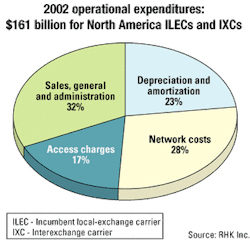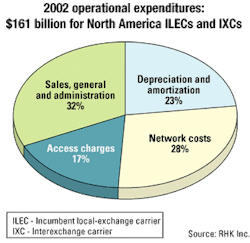Carriers want opex savings but differ in the methods of measurement
Market conditions, Wall Street, and increased scrutiny in general have led telecommunications executives to dictate that new optical transport technology must make existing networks more efficient and lower operational expenditures (opex) before they'll consider buying it. The problem for vendors is that no two carriers measure opex the same way.
According to Stu Elby, vice president of network architecture, enterprise technology, at Verizon Communications (New York City), "It is no longer intriguing at all to have some vendor come to me and say, 'If you use my box, it will cost you—in terms of capital spending—half of what you are spending today.' We see that as just the nature of comparing an old embedded technology to a new technology, so those aren't the arguments. The arguments have to be how you are changing the way that I do my business that's going to reduce my operations costs."
"We make decisions based on opex as well as capex [capital expenditures]," says Kathy Tse, district manager for optical transport planning at AT&T Labs (Bedminster, NJ). "We look at things like power cost, footprint, number and type of maintenance actions required, provisioning actions required. Some are easy to put dollar values to, like power costs...Other things are a little more difficult, but you can still look for directional trends."Service providers will have to reduce opex by 32% per year to keep pace with declining revenues, according to RHK (South San Francisco). "What we found is that revenue per bit and capex per bit had declined at roughly the same rate if you exclude the effects of the bubble," explains Shing Yin, senior analyst, telecom economics at RHK. "But opex per bit has not declined by that much. We also looked at our own forecast of traffic revenue, and that pointed to more of a gap on opex."
How is the opex argument won when every carrier and competing vendor is using its own assumptions and calculations to develop business models? "In general, there is quite of bit of skepticism," says Yin. "Vendors must make the business case generic for an average carrier, and there are no two carriers that are that alike, so it is very difficult to come up with a good opex analysis."
Nevertheless, carriers welcome any insights into ways new technology can help lower their network operating costs. "We will consider vendors' spreadsheets to see if they have thought of things that we haven't thought of, but at the end of the day, we are going do our own analysis," explains Jim Jackson, research director at BellSouth (Atlanta).
"Initially, we look at the capital costs associated with what we are doing with our embedded vendors," says Jackson, "and then we'll compare that to the cost of the newer, disruptive technologies. The newer players are not really aware of what we're paying today for existing equipment—our embedded vendors are being very aggressive about trying to maintain their business."
Saving labor costs is important at BellSouth—but the savings must be major. "If we can eliminate headcount, then that is something that we'll think about," notes Jackson. "If we eliminate 30 minutes of work to turn up 10,000 circuits, I'm not exactly buying it. We're looking at a cash flow analysis: What does it take to run our business from a capital and expense standpoint?"
Verizon measures its network opex in two general categories—operational support systems and labor costs—which are tracked on a per-circuit (or other unit) basis. "When we think about ways to save operations costs, we think about reducing the systems costs, although that is tough to do because typically we are adding new systems, not subtracting old systems," says Elby. "So it really is, how do you reduce the amount of hands it takes over time to provision a circuit or turn up a network?"
AT&T looks at vendors' analyses, but "the numbers that are in there aren't a huge amount of value to us," says Tse. Like Verizon and BellSouth, AT&T relies on its own modeling. "When someone gives a presentation on the provisioning savings of an all-optical switch, I have to benchmark that versus the capabilities that we have already," she says. "Sometimes there is a big disconnect between what they will be comparing it to and what we have in our network—I still see a lot of presentations where they are comparing things to ADM [add/drop multiplexing] rings. We are beyond ADM rings, so that doesn't really help me."

